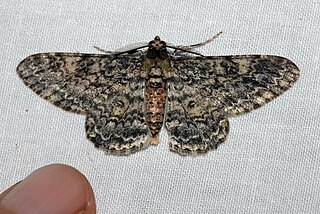
Chrysocraspeda is a genus of moths in the family Geometridae described by Charles Swinhoe in 1893.
Dithalama is a genus of moths in the family Geometridae.
Leucesthes is a monotypic moth genus in the family Geometridae described by Warren in 1902. Its only species, Leucesthes alba, was first described by Swinhoe in 1902. It is found in Australia.
Microcalicha is a genus of moths in the family Geometridae first described by Sato in 1981.
Oxymacaria is a genus of moths in the family Geometridae described by Warren in 1894.

Scopula is a genus of moths in the family Geometridae described by Franz von Paula Schrank in 1802.

Semiothisa is a genus of moths in the family Geometridae. It was erected by Jacob Hübner in 1818.

Cleora inoffensa is a moth of the family Geometridae first described by Charles Swinhoe in 1902. It is found in the Himalayas, Sundaland, the Philippines, Sulawesi and on the Solomons.

Eupitheciini is a tribe of geometer moths under subfamily Larentiinae, often referred to as pugs. The tribe was described by Tutt in 1896.

Mesoptila melanolopha is a moth in the family Geometridae first described by Charles Swinhoe in 1895. It is found in Nepal, China, Korea, Japan, Taiwan, India, Sri Lanka, Thailand, Vietnam, Malaysia and on Java, Bali and Borneo.
Scopula dimorphata is a moth of the family Geometridae. It is found in Asia, including China, Sulawesi and Bali.
Scopula sybillaria is a moth of the family Geometridae first described by Charles Swinhoe in 1902. It is found in western China, Hong Kong and possibly Borneo.
Dithalama punctilinea is a moth of the family Geometridae first described by Charles Swinhoe in 1902. It is found in Western Australia.
Lophophelma erionoma is a moth of the family Geometridae first described by Charles Swinhoe in 1893. It is found in the Chinese provinces of Hunan, Guangxi, Zhejiang, Fujian, Jiangxi, Hainan and Sichuan, and in the north-eastern Himalayas and Sundaland. The habitat consists of lower montane and upper montane forests.
Chloroclystis rotundaria is a moth in the family Geometridae. It was described by Charles Swinhoe in 1902. It is found on New Guinea.
Chloroclystis speciosa is a moth in the family Geometridae. It was described by Charles Swinhoe in 1902. It is endemic to New Guinea.
Gymnoscelis concinna is a moth in the family Geometridae first described by Charles Swinhoe in 1902. It is found on various Pacific islands, including Tonga, Fiji and the Cook Islands, the Austral Islands, Easter Island, Henderson Island, Pitcairn Island and the Society Islands.
Micrulia medioplaga is a moth in the family Geometridae first described by Charles Swinhoe in 1902. It is found on Borneo, Bali, Sulawesi and Sri Lanka. The habitat mostly consists of lowland forests, but it has also been recorded in lower montane forests.
Spiralisigna minutissima is a moth in the family Geometridae first described by Charles Swinhoe in 1902. It is found on Sumbawa, Bali, Peninsular Malaysia, Borneo and the Philippines.

Doratifera is a genus of cup-moth caterpillars in the family Limacodidae. The genus was erected by James Duncan in 1841. There are about 13 described species in Doratifera, found primarily in Australia. The are called cup-moths because of the shape of their cocoons.







